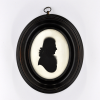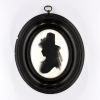Houghton, Samuel
Gender:
Male
Date and place of birth:
Unknown
Date and place of death:
dec. by July 1793, location unknown
Worked:
(fl. ca. 1783 to 1792)
Known places of work:
London, Edinburgh
Known techniques:
Painted on ivory and plaster
Known materials:
Ivory and plaster
Frames:
Turned pearwood, oval pressed brass & gold lockets
Signature:
Recorded
Introduction:
An artist of high accomplishment, Houghton worked on ivory and plaster with equal skill, and, without trade labels assisting attribution, his style is difficult to distinguish from that of John Miers. Commentators, however, found no link between them until 2021 research revealed a series of significant advertisements in the CALEDONIAN MERCURY newspaper where, in July 1791, Houghton announces his arrival in Edinburgh “from London” as “long a pupil” of John Miers. Later editions, as seen below, prove Houghton's career terminated exactly a year later.
It seems apparent when Miers moved from his first to his second London address in May 1791, Houghton, for reasons unknown, left the studio and moved to Edinburgh some time in June 1791, placing his sole advertisement in the CALEDONIAN MERCURY on July the 2nd.
McKechnie states that from May 1791 "the hand of an unidentified artist" sufficiently distingushable from the style of Miers (and Houghton) could be discerned working at Miers' 2nd London studio. This suggests the anonymous artist filled the void left by Houghton's departure.
How and when Miers and Houghton became acquainted is unknown. In August 1783 Miers added a jewellery work on ivory to his options and as Houghton is known to have painted work for jewellery settings, it's possible he became Miers' pupil at this time.
By November 1784, Miers claimed to have painted 3000 likenesses in Leeds alone and "...an immense number elsewhere". Even allowing for hyperbole, demand was high, would continue to rise and require, as is now known, an assistant of talent to help with commisssions. This all suggests an unquantifiable percentage of Miers' profiles ca.1783-1791 are by the hand of his pupil and faithful copyist, Houghton.
Between October 1786 and August 1788, Miers settled his family and business in Edinburgh. The length of his stay was indicative of his success and seeded the resolve to establish himellf in London. It's plausible Houghton travelled with him. As Miers' employee he would have been aware of financial opportunities for a resident profilist of quality in Scotland's capital.
It's also credible that Houghton's marriage in August 1791, barely a month after placing his sole advertisement, suggests an earlier acquaintance with his spouse, and by extension the city. Lending weight to the theory is the fact that Miers, 3 years earlier, displayed samples of his work at "Mr. Moncrieff's", an apothecary, and Houghton's wife was formerly wed to apothecary Robert Moncrieff.
In July 1792, Houghton’s sole pupil, George Bruce, informs the public “…the business is now carried on in all its branches by George Bruce for…Mr. Houghton’s family and himself”, while a March 1793 advertisement mentions “…the LATE Mr. Houghton”. Therefore, a year after settling in Edinburgh, a malady terminated Houghton’s career, then his life, thus explaining the rarity of his trade-labelled profiles.
No doubt using Houghton’s celebrity, his talented pupil traded as "HOUGHTON & BRUCE " between 1792-6 before marrying Houghton’s widow and working under his own name from 1797. Therefore this trade label must now be regarded in a different light. Any profile bearing it is either a Houghton duplicate or by Bruce, copying Houghton's style, which, judging by his early output, he was capable of producing. In a CALEDONIAN MERCURY advertisement in June 1804, he states he "...retained all his original sketches, also those of his predecessor, Mr. Houghton, so those who have sat to each may have...copies".
Although Houghton died some time between July 1792 and March 1793, no obituary or registration of his death could be found either in Scotland or England.
A CORRECTION - 4 BRUNSWICK STREET written in pencil on the Trade Label of a profile of General (Banastre) Tarlton (1754-1833) was suggested by McKechnie and others as potentially being Houghton’s home address. Research, however, discovered Brunswick St. to be in Edinburgh’s ‘Eastern New Town’, the plans of which were not laid out until September 1819, more than 25 years after Houghton’s death.
Revised 5 April 2022 (Brian Wellings)
Additional research about Samuel Houghton:
Source: McKechnie (Author of, British Silhouette Artists and their Work 1760-1860)
Houghton, Samuel (McKechnie Section 4)Houghton, Samuel (McKechnie Section 5)
Source: Joll (Hon. Secretary of the Silhouette Collectors Club and Editor of the Club's newsletter)
Houghton, Samuel (SCC Newsletter August 2008)Source: Wellings (Silhouette collector and Contributing Editor)
Houghton, Samuel (Recent research, April 2022)

